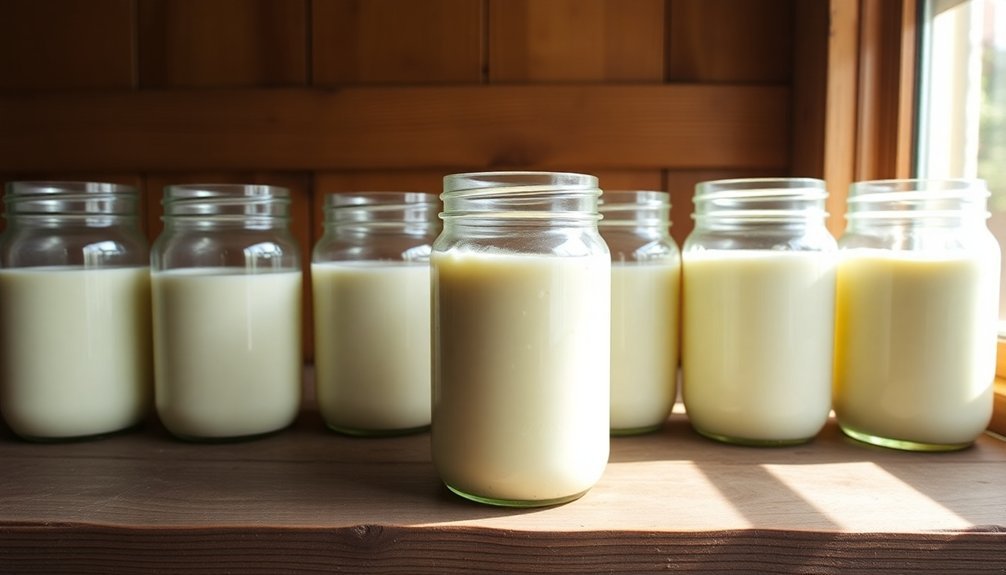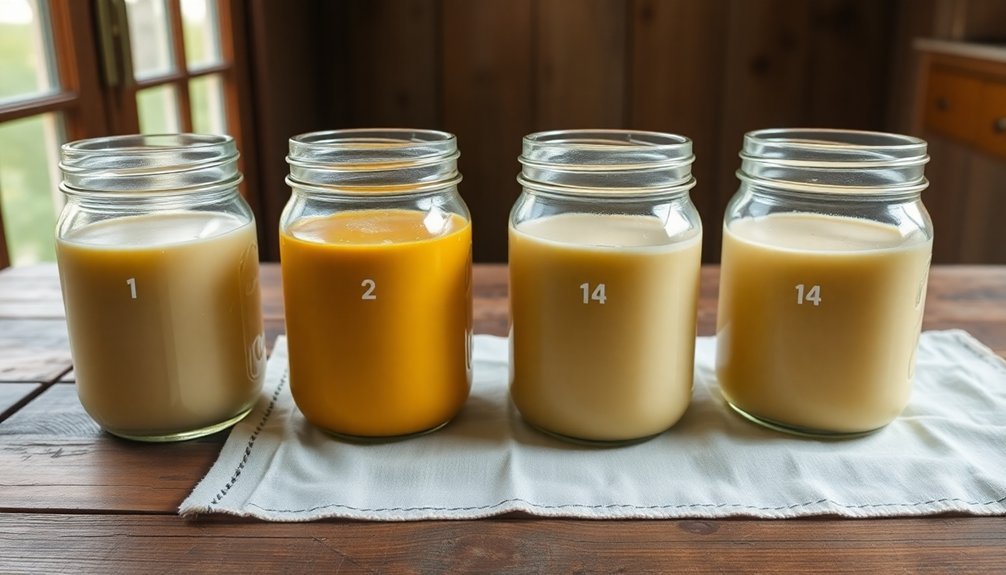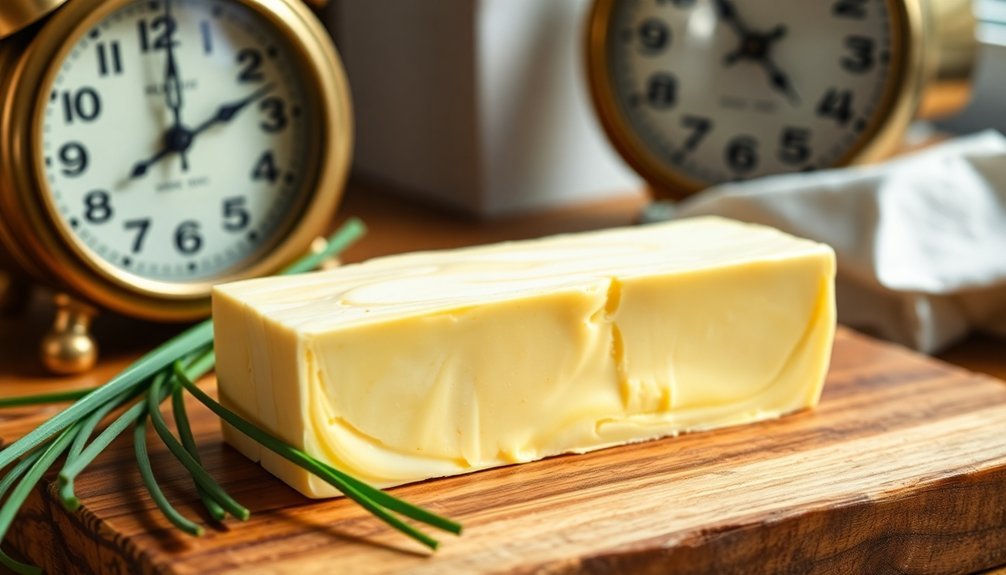You can culture butter for different durations to achieve your desired flavor intensity. The quickest method takes just 24 hours, producing a mild, tangy taste perfect for everyday use. A three-day culture develops deeper, more complex notes, while a one-week fermentation creates rich, nuanced flavors. For those seeking convenience, try the overnight method that takes just 8-24 hours. True butter enthusiasts often opt for the two-week process, which yields the most intense and sophisticated flavor profile. Understanding these timelines will help you craft the perfect cultured butter for your taste preferences.
The 24-Hour Basic Culture

The 24-hour basic culture serves as your foundation for creating flavorful, homemade cultured butter.
You'll start by combining heavy cream with your chosen culturing agent, such as live-culture buttermilk or yogurt, in a clean container. After thoroughly mixing the ingredients, cover the container with cheesecloth to allow proper air circulation while protecting against contaminants.
You'll need to maintain a consistent room temperature between 70°F and 75°F (21°C-24°C) throughout the culturing process. Place your container in a warm spot in your kitchen, and if needed, drape a towel over it to help maintain the temperature. This method is more cost-effective than purchasing store-bought cultured butter, with initial batches costing around $12 to make.
During this 24-hour period, you'll notice the mixture gradually thickening and developing a distinctive tangy aroma.
Once your cream has fermented for 24 hours, you'll need to refrigerate it for at least an hour before churning. This chilling step is essential as it keeps the butterfat firm during the churning process.
After chilling, you'll whip the cultured cream until it separates into butter and buttermilk, then strain through cheesecloth to collect your finished butter.
Three-Day Deep Flavor Development
For devoted butter enthusiasts seeking deeper, more complex flavors, a three-day culturing process delivers exceptional results. During this extended fermentation period, you'll need to maintain a consistent temperature between 70°F and 75°F to guarantee ideal bacterial activity.
Start by placing your cream in a yogurt maker or a draft-free warm spot in your kitchen. The quality of your final product depends heavily on using non-ultra-pasteurized cream. You'll notice the cream gradually thickening over the first 48 hours, but allowing it to ferment for a full 72 hours will develop more pronounced, nuanced flavors.
Monitor the cream's consistency and smell throughout the process – it should become considerably thicker with a distinctly tangy aroma.
Once your cream has completed the three-day fermentation, chill it for at least an hour to firm up the butterfat. Then, churn the cultured cream using a stand mixer until it separates into butter and buttermilk, typically within 5 minutes.
Strain out the buttermilk and wash your butter thoroughly with ice-cold water at least twice. You'll want to squeeze out every bit of liquid using cheesecloth to guarantee maximum shelf life.
For the final touch, you can add sea salt to enhance the butter's complex flavor profile.
One-Week Complex Fermentation

Advanced butter artisans occasionally venture into week-long fermentation territory, pushing the boundaries of flavor development to its limits. If you're ready to explore this intense culturing method, you'll need to maintain strict temperature control, ideally keeping your cream at the lower end of the range at around 60°F to prevent over-souring. After reaching room temperature, wait 12 hours before beginning the extended fermentation process.
You'll want to monitor your fermentation closely throughout the week, checking for gradual changes in texture and aroma. The bacterial cultures will continuously work on the cream's lactose and citric acid, creating increasingly complex flavor compounds. You can use live cultures from yogurt or buttermilk to start the process, but you'll need to guarantee they're fresh and active.
During this extended fermentation, you'll notice your cream becoming progressively thicker and more aromatic. It's essential that you check daily for any signs of over-souring or off-flavors. If you detect any unusual odors or excessive sourness, you should halt the fermentation immediately.
Once you've achieved your desired flavor profile, you'll need to thoroughly chill the cream before churning to guarantee proper butterfat separation and texture development.
Quick Overnight Butter Culture
Making cultured butter doesn't always require week-long fermentation – you can create delicious, tangy butter in just 24 hours using a quick overnight culture method.
To start, you'll need 1 litre of cream and a culturing agent like plain yoghurt, cultured buttermilk, or milk kefir. Mix a tablespoon of your chosen culture with the cream, cover the container, and let it sit at room temperature away from direct sunlight.
You can taste the cream after 8 hours to check its tanginess, though the full process typically takes 24 hours. If your room is cold, you might need to extend the fermentation time.
Once your cream has thickened and developed the desired tang, transfer it to a mixer or food processor. Beat it until the mixture splits and butter clumps form, which usually takes about 5 minutes.
Strain the butter from the buttermilk using cheesecloth or a fine mesh strainer. Rinse the butter thoroughly with ice-cold water until it runs clear, then squeeze out any remaining buttermilk.
Finally, add salt if desired and shape your butter into your preferred form.
Two-Week Maximum Flavor Profile

The two-week culturing method produces the most complex and intense flavor profile possible in homemade cultured butter.
You'll start by fermenting your cream at room temperature (70°F to 75°F) for 24-48 hours, then shift to refrigerated fermentation for the remaining time. During this process, you'll need to monitor the temperature carefully, keeping it between 68°F and 78°F during the initial fermentation.
To achieve the best results, you'll want to use specific bacterial cultures like Lactobacillus brevis, which creates a richer, more buttery flavor. You can combine this with viili culture for enhanced results.
Check your cream every 6-8 hours during the initial fermentation to monitor its flavor development. Once you've moved the cream to the refrigerator, the fermentation will continue at a slower pace.
After completing the two-week culture, you'll need to wash your butter thoroughly with cold water to remove excess buttermilk.
Store your finished butter in the refrigerator for up to a month, or freeze it for 4-6 months. If you're planning to consume it quickly, you can keep it in a French butter bell at room temperature.
Frequently Asked Questions
Can I Culture Butter at Different Altitudes Without Affecting the Process?
Yes, you can culture butter at any altitude without issues. The fermentation process isn't affected by elevation – just maintain consistent temperatures between 70°F-75°F for ideal results during your culturing time.
What Happens if My Power Goes Out During Culturing?
If your power goes out, you'll need to move your culturing cream to a cooler with ice within 4 hours. Keep it at 40°F or below, or you'll risk spoilage and need to start over.
Does Stirring the Cream During Culturing Affect the Final Taste?
You shouldn't stir your cream during culturing, as it can disrupt bacterial growth and affect flavor development. It's best to mix once initially with your culturing agent, then leave it undisturbed while fermenting.
Can I Use Different Types of Cultured Milk Instead of Buttermilk?
Yes, you can use several cultured milk alternatives instead of buttermilk. You'll find yogurt, sour cream, and kefir work well. Just thin thicker options with milk or water to match buttermilk's consistency.
How Do Seasonal Changes in Cream Affect Culturing Times and Flavor?
You'll notice faster culturing in summer due to warmer temperatures and richer flavors from grass-fed cream. In winter, you'll need longer culturing times, and cream from hay-fed cows produces different flavor profiles.
In Summary
Whether you're aiming for a mild tang or intense depth, you've now got the tools to culture butter exactly how you want it. From the basic 24-hour process to the complex two-week fermentation, each timeline offers unique flavor profiles. You'll find that longer culturing times generally yield richer, more complex tastes, but even quick overnight cultures can enhance your butter considerably. Choose what works for your schedule and taste preferences.





Leave a Reply